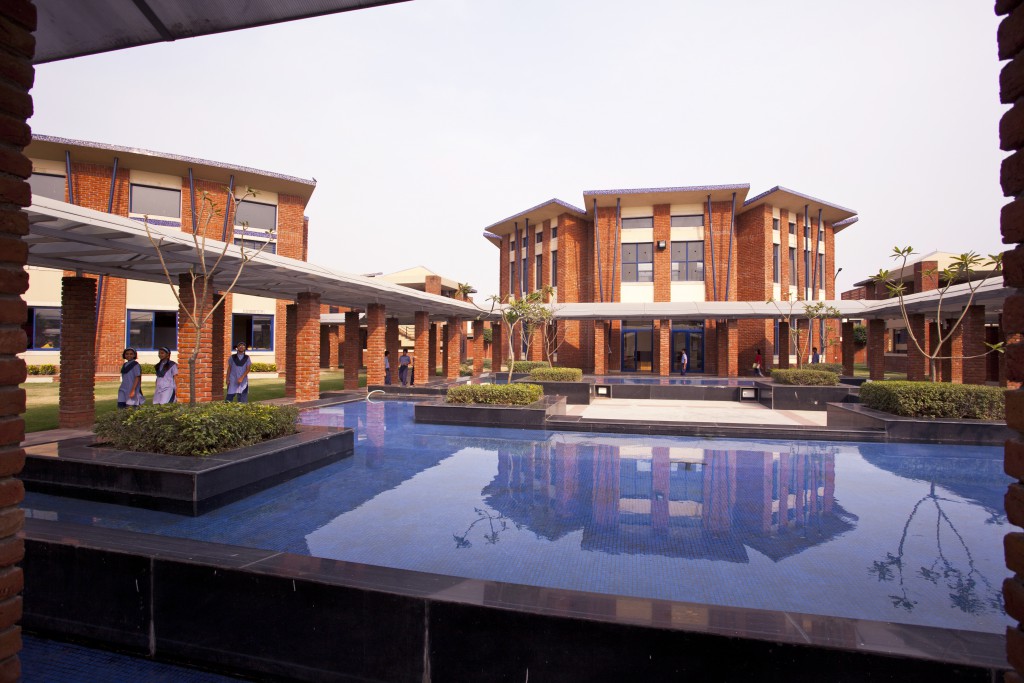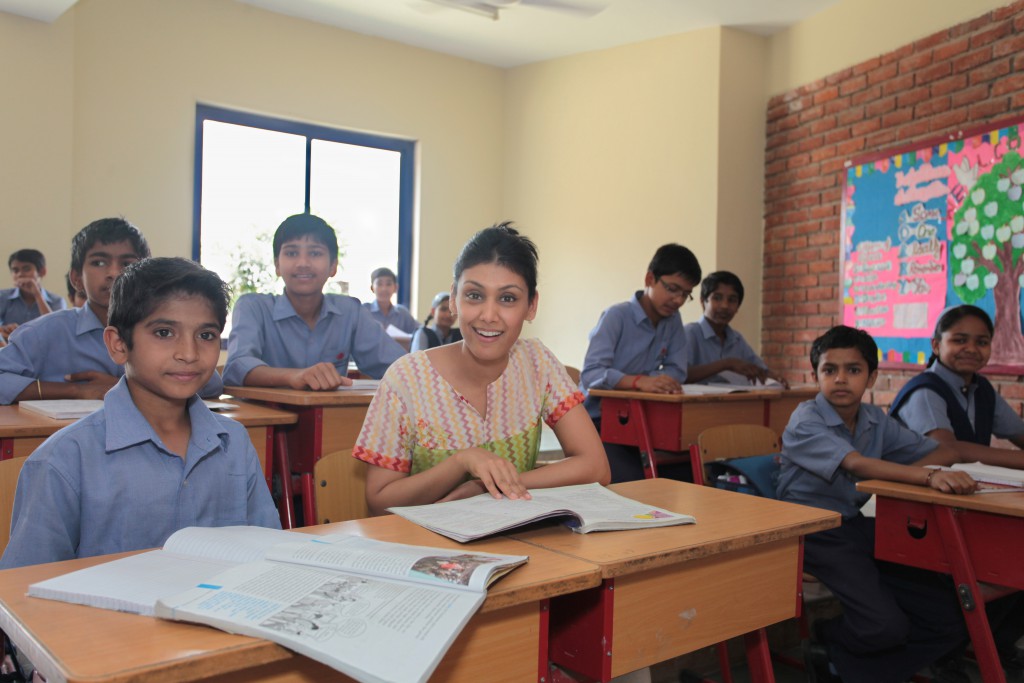Roshni Nadar Malholtra is the daughter of Indian industrialist and philanthropist Shiv Nadar, founder and chairman of HCL and of the Shiv Nadar Foundation, one of India’s largest private philanthropic organizations. The Foundation practises creative rather than corrective philanthropy, she explained to Caroline Hartnell; it is all about ‘creating long-term, sustainable institutions of significance’, lasting beyond the lifetimes of the founder and family members. This includes the flagship programme VidyaGyan, whose ambitious aim is to make leaders out of the most talented rural children in Uttar Pradesh, an Indian state as large as Brazil.
Can you tell me a bit about the Shiv Nadar Foundation and your role in it?
I am one of the Foundation trustees, along with my parents, my husband and two external members. The Shiv Nadar Foundation was founded in 1994, and my father set up the first institution under the Foundation in 1996, the SSN College of Engineering in Chennai. I think he chose education specifically because he felt that he was a product of education. Until 2009, it remained the Foundation’s only initiative. Since then, other institutions have been launched, but the focus on education has remained – as has the focus on building institutions, whether it’s institutions such as colleges or universities for higher education, or K-12 schools for urban children or residential schools for rural underprivileged, meritorious children.
It’s very difficult to measure the impact of institutions in a short span of time. We’re talking about a long-term, strategic investment: we envisage that the real impact of the Shiv Nadar Foundation will only be felt in the years to come. So I think the whole premise of the Foundation is that the institutions that we create and the Foundation itself should last beyond the lifetimes of the founder and family members.
How connected are your two roles as executive director and CEO of HCL Corporation and trustee of the Shiv Nadar Foundation?
They are very closely related because the Shiv Nadar Foundation is completely supported by HCL Corporation. The corporation looks at the Foundation as a long-term, committed social investment, and not just as charity or philanthropy. On the other side, being a trustee of the Shiv Nadar Foundation keeps it within the family, because the amount that we’ve committed and continue to commit is such a large sum that it needs to be very intelligently managed. So the Corporation and the Foundation are two sides of the same coin.
The money is committed annually, isn’t it, rather than being an endowment?
That’s right. As of today I think HCL Corporation has already donated and the Shiv Nadar Foundation has already spent $500 million, and our commitment is that over the next five years that number will go up to about $1 billion.
VidyaGyan is your flagship programme, winning several major awards in 2014. What is so special about it?
It’s the VidyaGyan leadership academy. We have two of them and they are in Uttar Pradesh, the largest state in India with a population of 200 million. They are residential schools which go from grade 6 to grade 12. We run a huge school selection process to find the right children for the academy. Let’s say that there are 40 million children in Uttar Pradesh who are of school age. Annually, we test about 200,000 students, of whom the two schools will take about 600. So it’s a highly ambitious project because finding those diamonds in the rough is not easy.
‘These children have been phenomenal in the amount that they’ve developed. And hopefully in my lifetime, one of the VidyaGyan students will be the prime minister of India – that would be exciting.’
Once they are with us in VidyaGyan, the aim is not just to educate them – these are very bright students; hopefully, in time, they will go out and become leaders. What we see in India at the moment is that leaders – political as well as corporate – tend to come from urban and semi-urban backgrounds. The 60 per cent of the country who live in rural areas are not really getting the opportunities to become leaders, because they don’t have access to education. So the whole initiative was started with the idea of identifying students at a young age – grade 6 means 10 or 11 years old. It’s a very long-term project, because there’s no guarantee which students will be successful or when. I can’t tell you that a child that we’ve taken aged 10 or 11 is going to be a leader tomorrow. How do you measure leadership? But these children have been phenomenal in the amount that they’ve developed. And hopefully in my lifetime, one of the VidyaGyan students will be the prime minister of India – that would be exciting.
You talk about creating long-term, sustainable institutions of significance. What do you mean by sustainability here? Does it mean that VidyaGyan will be able to continue without support from the Shiv Nadar Foundation?
Apart from VidyaGyan, which is fully supported by the Foundation, all the other institutions under the Shiv Nadar Foundation umbrella – the Shiv Nadar Schools, the SSN College of Engineering, the other SSN institutions, the Shiv Nadar University – are already operationally sustainable. We realize that they will never be sustainable when it comes to capital investment – the actual building of the campuses and so on – so the Foundation is committed to doing that; but operationally all these institutions are sustainable because they charge fees.
The only one that is absolutely dependent on the Foundation is VidyaGyan and I think that will be indefinitely supported by the family, though we’re open to other philanthropists coming in. One of the things that people abroad, especially from the diaspora, often mention to us is that they want to donate to India but don’t know how to. So we are definitely open to partnerships with organizations, companies, other philanthropists. VidyaGyan might have been created by the Shiv Nadar Foundation, but it doesn’t belong to us. It really belongs to the children of Uttar Pradesh, so that’s the vision.
Your website talks a lot about creative philanthropy. What do you mean by this?
One of the things that the family, particularly me and my parents, find interesting is that if you go back to the first half of the previous century in the US – taking the US as an example because I think philanthropy is most advanced and developed there – what philanthropists like the Carnegies or the Rockefellers were doing was creating institutions. Although these foundations were extremely large and quite forward-thinking for that time, I don’t think they could have imagined the legacy they were creating.
‘I can’t say to you, “I live in a country of 1 billion and I’m touching 2 million or 3 million lives.” We don’t have fancy numbers to show, but I think we concentrate on depth of philanthropic impact and not breadth.’
On the other hand, there’s a corrective approach to philanthropy that, say, the Gates Foundation pursues. They identify a problem and invest heavily in finding a solution. There’s a start date, an end date, desired results and measurable outcomes. It works more like a project. It was a conscious decision on our part to take the approach of creating institutions, because coming from HCL, the other organization that my father has created over the last 29 years, he felt he had more experience in creating institutions.
I can’t say to you, ‘I live in a country of 1 billion and I’m touching 2 million or 3 million lives.’ We don’t have fancy numbers to show, but I think we concentrate on depth of philanthropic impact and not breadth. For a country to really benefit from philanthropy, especially one like ours with a population of a billion, both kinds of models, corrective and creative, need to exist. But we can only focus on one and that’s what we’re doing.
I understand yours is the first Indian foundation to establish global benchmarks in philanthropy in India. What are these benchmarks?
In India, there are more than 200,000 trusts and foundations but many of them have extremely dubious reputations. So one of the things that we decided we were going to do with the Shiv Nadar Foundation was regular housekeeping abroad. We would publish an annual report that would be absolutely public; and it would not just be us saying how much we spent, it would be audited by a global auditor such as KPMG or PWC and reviewed in the UK. That is one of the global benchmarks.
Even now if you try to access a lot of annual reports within India from abroad, it isn’t easy. It’s not a question of whether people are doing things in the wrong way; it’s just making the whole process transparent. We organized a huge event about this and invited philanthropists from all over India and people from the World Bank and the UN. The event wasn’t about the Shiv Nadar Foundation; it was basically a forum to discuss how philanthropy and CSR could become more accountable and transparent within India, something which is lacking at the moment.
Our SSN Institutions has been now around for almost 20 years and the students have started showing early signs of leadership. These are children who often come from rural or semi-rural and, in many cases, underprivileged backgrounds, and a lot of them have gone on to become senior executives at global companies all over the world. Some of them have actually begun creating scholarships within the institution for other students, or setting up scholarships within their villages, which has nothing to do with our initiative. This spiral of inspiration is extremely heartening to see.
How important is it to you that the Shiv Nadar Foundation is a family foundation, controlled by the founding family?
In the SSN Institutions, which are our oldest initiative, one of the family sits on the board, but the chairman and the rest of the board members are external, so they are quite autonomous. The other initiatives, including VidyaGyan, only started in 2009, and the only reason why the family is so involved in these is that currently we are the chief funder and drive the strategy. But tomorrow, if we have other people who want to be part of the movement, we would definitely welcome that, because we realize that the only way it’s going to become sustainable in the long run is if other people get involved.
What role do you see for private philanthropy in developing and emerging economies, and how can philanthropy work with government and business?
I think one thing that is extremely important to recognize – at least we see this in India – is that even though philanthropists might be extremely wealthy, they cannot do the work of the government. The government in any country, developing or developed, continues to be the largest welfare provider.
That said, it has been extremely helpful for us, as well as other philanthropists in India, that there are opportunities for public-private partnerships, because the government has networks within the country that private philanthropists don’t. So I think it’s important for both sides to realize that there are a lot of initiatives that can be done in partnership, especially because most of the private philanthropists in India are well-known industrialists, so they have proved their mettle, so to speak, at least in the corporate world. So government should do what they do, and philanthropists should continue to act independently, too, but there are also many opportunities for them to work together through public-private partnerships.‘So government should do what they do, and philanthropists should continue to act independently, too, but there are also many opportunities for them to work together through public-private partnerships.’
What about philanthropy and business working together, especially in the light of India’s new CSR law?
I think there are two problems with the new law. First, 2 per cent of the post-tax profit of India’s biggest companies is a huge sum of money coming into the social sector, but the sector isn’t organized enough to be able to absorb all of it. Second, the law is not enforceable, so while it’s an extremely good law on paper, the implementation leaves much to be desired. We, and all our group companies, are going ahead with this – we have had a legacy of CSR. But there are many other companies that are wondering what they’re going to do with this money.
You’ve talked about bringing in others to support your institutions. Is there potential for bringing some of these companies into partnership with you?
Absolutely. That’s something we’ve been talking to some companies in India about. But it’s a double-edged sword, because a lot of them don’t understand that we are not asking for the money for ourselves, but for the institutions. It isn’t easy for us to go and fundraise outside because we are extremely well-endowed. You have to persuade them that they’re not investing in the Shiv Nadar Foundation, they’re investing in that particular child or student who can be a successful leader tomorrow. And it’s a very different discussion.
How do you see the Foundation developing in the future? What would you most like to achieve as a philanthropist?
One of the things that we have been working on in the Foundation is how to continue building on the level of governance we have. Our own group companies are expanding their board of directors, bringing in a more diverse group with experience from all over the world, building a finance committee, building an audit committee, building an HR and remuneration committee, bringing in a lot more framework and structures. My personal vision – and I think that of the family – is that in a couple of years we want the Shiv Nadar Foundation to function like one of our group companies, almost as if it was a public-listed company, with the same level of organization, transparency and governance, and hopefully engaging a lot more outside partners. That is something that we’re really working towards. It’s not easy because you don’t always find the right fit and we don’t want a bunch of fancy names on our boards and committees; we want people who are willing to give that time and commitment. It’s not always easy. I’m 33 years old and the Shiv Nadar Foundation is 20 years old, so we’re kind of contemporaries growing together, and I feel both of us have a lot to achieve and are still going strong.
Too soon to be looking at what you’d like to achieve as a philanthropist!
Far too soon! My father’s turning 70 this year, and he’ll say ‘not in my lifetime, but maybe in your lifetime’ and we just laugh. It’s going to be a couple of more decades definitely.
Caroline Hartnell is editor of Alliance magazine.

![Roshni Nadar 1 DSC_3873[1]](https://alliancemagazine-1d0ab.kxcdn.com/wp-content/uploads/2015/03/Roshni-Nadar-1-DSC_387311-1024x683.jpg)






Comments (0)